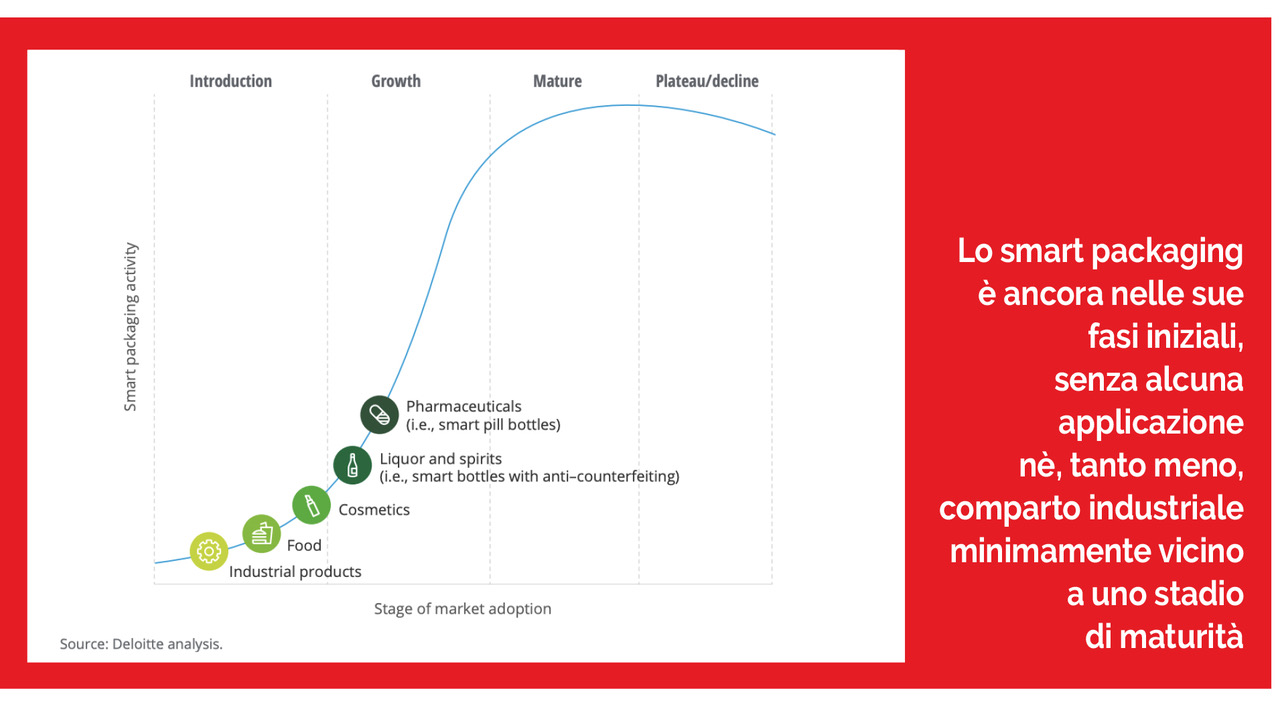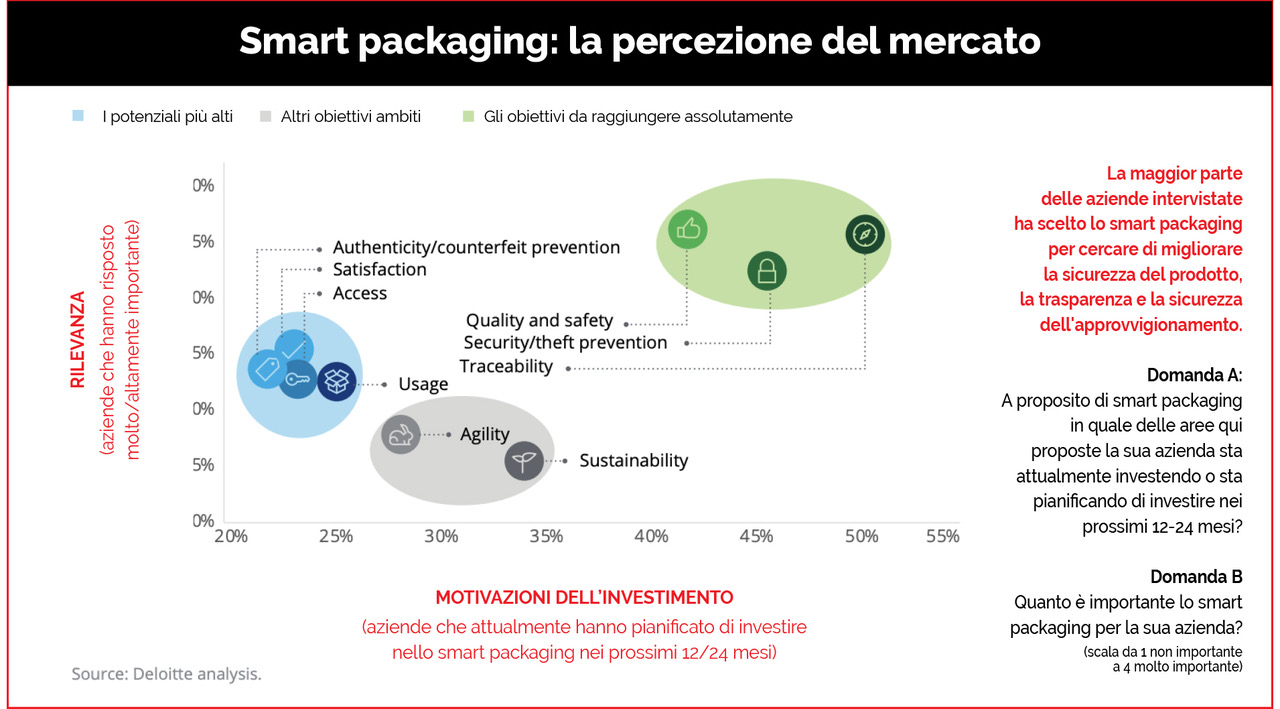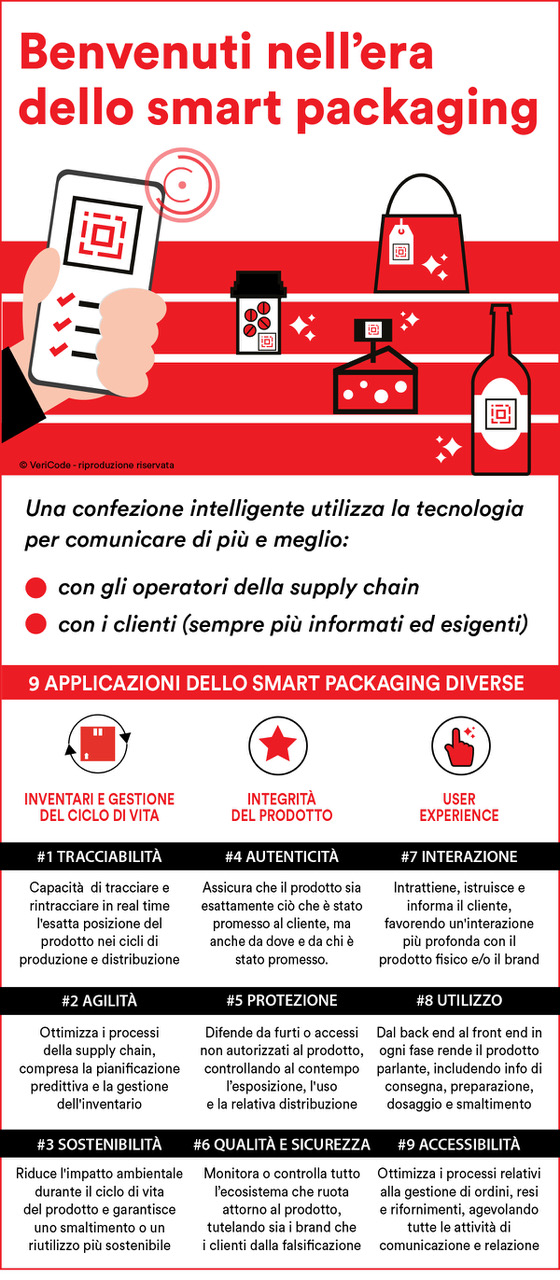
Smart packaging evolution: PACKAGES BECOME SPEAKING PACKAGES
Smart packaging evolution means mixing technology and strategy, developing new packaging concepts that make products intelligent and communicating. Packing and packaging use increasingly advanced coding technologies, such as:
- two-dimensional codes
- QrCode
- sensors (in particular for the monitoring and control of food, medicines or special cosmetics)
- RFID or NFC tags
The starting point of smart packaging is not only aimed at supporting the tracking and traceability of products in the logistics and distribution field. In fact, especially in recent years, the evolution of mobile technologies and apps has also enhanced the solutions associated with image recognition and new certification models for products and associated information, to protect not only producers but also end customers from the market of fakes and from counterfeiting. These solutions, enhanced by the creativity of marketers, ensure that smart packaging contributes to positively change the entire supply chain: from the factory to the consumer. Protecting producers and consumers.
«If we mix technology with traditional packaging - explains Massimo Giordani, vice president of the Italian Marketing Development Association - we get something different, with new potential. We access an unexplored world: not so much because the technologies are innovative, rather, because the human imagination can use and combine them in ever-changing ways to communicate its message more effectively. This approach to next-generation packaging can become as the watermark in the paper money: a means of obtaining important information».
MAKE YOUR PRODUCT RECOGNIZABLE IN ITS AUTHENTICITY
Smart packaging, today and tomorrow
Yesterday the packaging was the result of a purely functional packaging process. The target? Ensure containers suitable for the storage, transport, delivery and shelf sale of products. Beyond the more or less functional design and the choice of materials, in reality the only intelligent component of the packaging was associated with the labeling system used: from the common one-dimensional barcode to the use of two-dimensional codes such as, for example, Data Matrix. In the last 20 years, the world of production and distribution has begun to experiment more and more intensively with the use of RFID technology integrated in smart labels, as a solution for faster handling of goods thanks to a massive reading to the most basic antitheft applications. The trailblazers, on the other hand, have sensed with great foresight the opportunity associated with smart packaging based on univocal radiofrequency identification, using RFID tags as a solution capable of triangular logistic handling, anti-counterfeiting and anti-fraud ensuring a complete system of tracking and traceability.

Today, technological evolution and the pervasiveness of perpetually smartphone-gifted users have led marketing to embrace smart packaging to review the very concept of packing. Going beyond the concept of mere wrapping, more or less colorful, printed with as much information as possible, the product containers have been transformed into powerful vectors of attention and communication. Smart packaging, in fact, exceeds the limits of the analog to open the door to the infinite space of digital communication.
Not just storytelling, gamification and engagement
In the analog era, packaging, in addition to describing the ingredients, has been an opportunity to develop storytelling and gamification channels. Whatever bit of free space on the packaging has been used to tell the value of the workmanship, the history, the tradition, the research and the development. Competition on the shelves of the large-retail chains has led marketers to add spaces dedicated to promotions, points collections or games. The arrival of the QR Codes stamped on the packages has increased engagement and loyalty strategies, which then evolved into the various techniques associated with augmented reality that inaugurated more sophisticated gamification initiatives, based on a much more suggestive animated interactivity. Meanwhile, consumers have also evolved, they have become more informed but also much more demanding (and with the spread of e-commerce they have become even more so).
Smart packaging for brands is no longer just an opportunity to manage back-end activities: it is a way to manage front-end activities, responding to consumers’ change in an increasingly timely, relevant and considerable way. Technology, in fact, allows to give customers the guarantee that the purchased product has a unique certificate of authenticity.

How and why the packages speak to us
Today omnichannel customers (according to the Politecnico di Milano in Italy over 2 consumers out of 3) know and recognize the technologies useful to get more information on products: thanks to the dedicated apps, framing an image or a code allows them to view in-depth content, videos, quizzes, social pages, prize games and so on. In addition to the playful component, the issue of products quality and information associated with them is an essential basic. The smartification of the world, associated with the progressive affirmation of the Internet of Things, guarantees the trackability and traceability of ingredients and components and processes also to final consumers. The smart package, in fact, promotes both the product and the brand by its certifying the origin and provenance of the products marketed, guaranteeing the quality of the raw materials used, the production and distribution processes, also including details related to sustainability.

Smart packaging: applications along the supply chain
There are several application areas of smart packaging.
- Supply chain logistics: Smart packaging optimizes supply chain processes and offers greater agility in logistics planning. This mode leads to better inventory management as brand owners follow the journey of products and packages through every stage of the supply chain, including manufacturing, shipping and final delivery.
- Product safety: smart packaging plays an important role when it comes to product safety. Products can be tracked via digital apps and GPS technology. Tamper-proof sensors can be used effectively to ensure product integrity protection. In addition, sensors and diagnostic indicators can monitor product information such as air-tight, storage time and temperature and send alerts if key indicators are compromised. The integration of sensors into the packages facilitates the monitoring of the state of food, reduces food waste, extends the shelf life and improves the overall quality of the food. In fact, these sensors can be designed to measure freshness indicators and provide a product quality index in real time, measure temperature changes or identify the presence of harmful components. Additional features can be added to provide protective functions, such as packaging with a coating that acts as an oxygen barrier to prevent spoilage. These methods can replace expensive techniques currently used to monitor food products and increase samples throughput. However, most sensors are still under development and require significant work before massive implementation in the real world. Some issues, such as sensitivity, selectivity, robustness and safety of detection materials due to potential contact or migration in food, still need to be arranged.
- Consumer experience: smart packaging strengthens the engagement and interaction between the consumer and the product. The use of QR codes and other technologies, such as audio or video, can be used to educate and inform consumers about the products contained within. Augmented reality (AR) and virtual reality (VR) experiences are a rapidly growing segment of the consumer experience, which further enhances this process. Not to mention that, with the development of NFC integrated into the Android ecosystem, the horizon of communication embraces the entire context of trackability and traceability in support of all after-sales services.
- Marketing: smart packaging allows new strategies of engagement, but also of study and behavior management, in a logic of personalization of the offer that is increasingly precise, contextual and relevant. Through the so-called martech platforms, brands can centrally direct the entire orchestra of communication that unfolds through any touchpoint used by customers in intersecting products and brands (and vice versa), also embracing the entire universe of social media. Products are more user-friendly and allow for better customer feedback, which allows brands to better understand the usage behavior of their target audience. Certifying the authenticity of the product by making available to end customers all the information that guarantee quality and authenticity, therefore becomes an indispensable value for the entire supply chain.
Smart packaging evolution
Combining technology and strategy, Vericode is the ultimate frontier of smart packaging. Smartphones in hand, operators and end customers can access service modes that allow you to evaluate the authenticity, or otherwise, of a product in a unique and certified way. The system uses an artificial intelligence system based on neural networks to analyze suspicious events along the supply chain. Always and in any case, the platform offers the possibility of following each product along the entire supply chain, with analysis and business intelligence tools capable of offering, within an easy-to-use dashboard, various reports and alerts.
- Log in to post comments